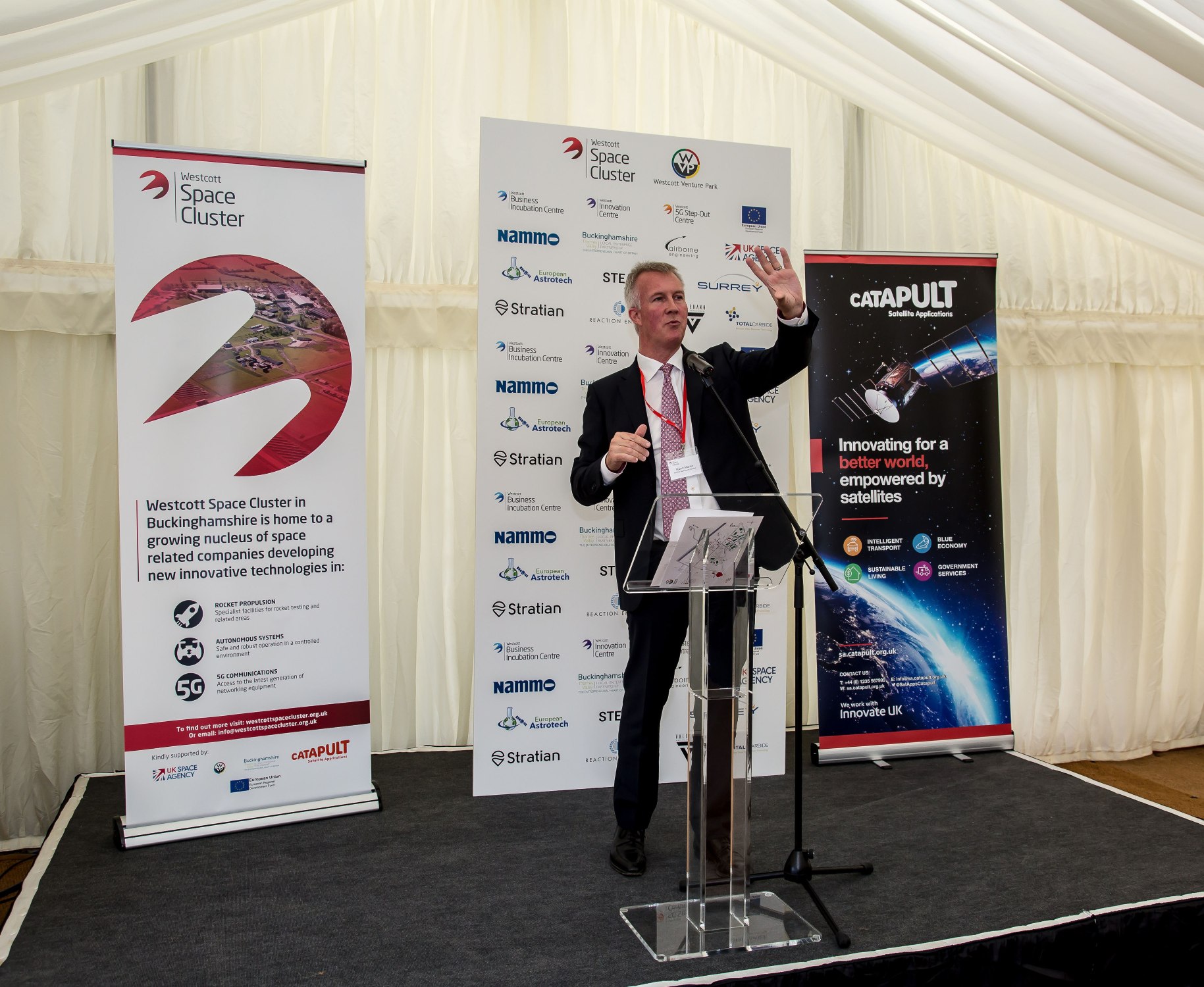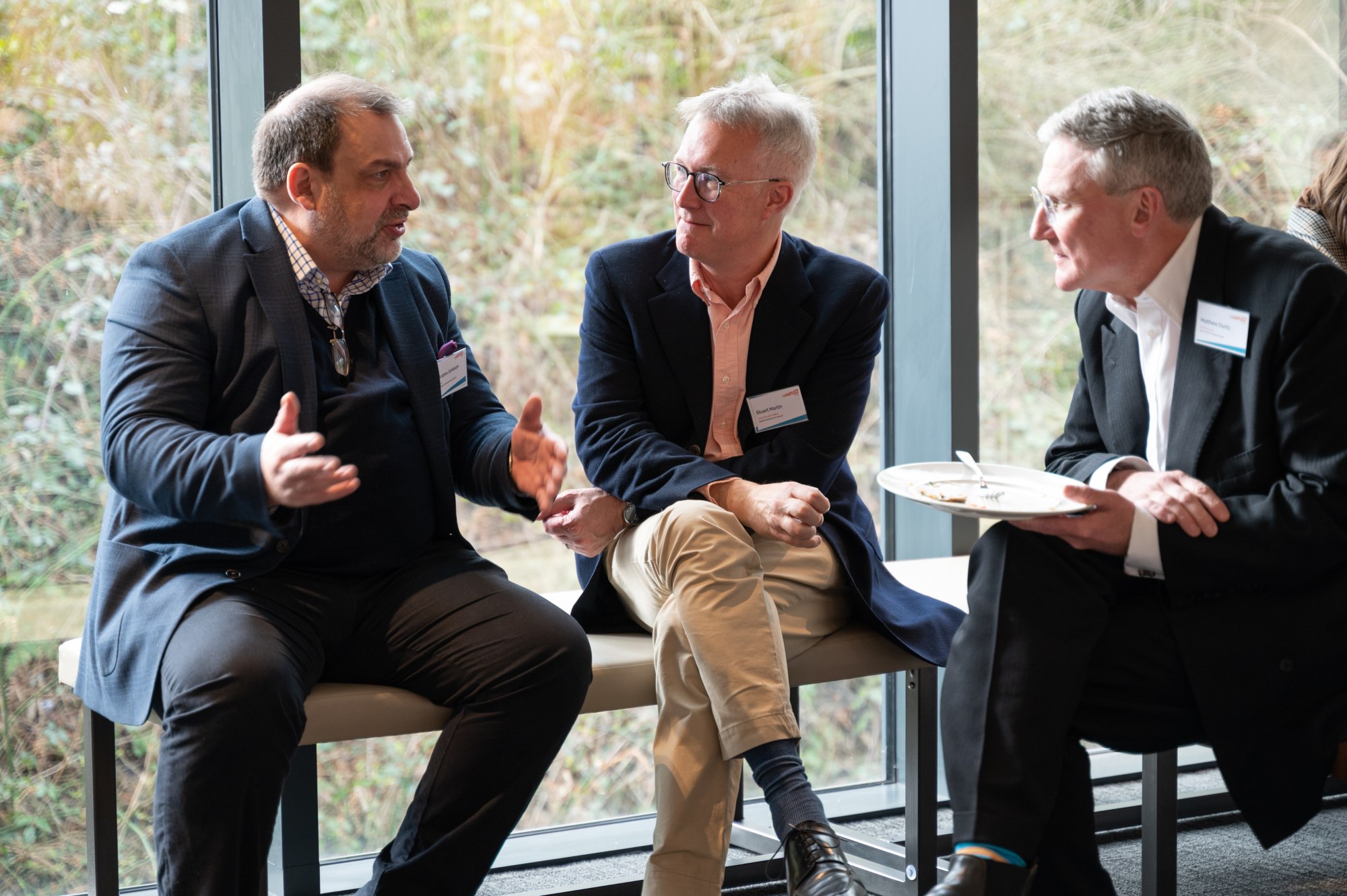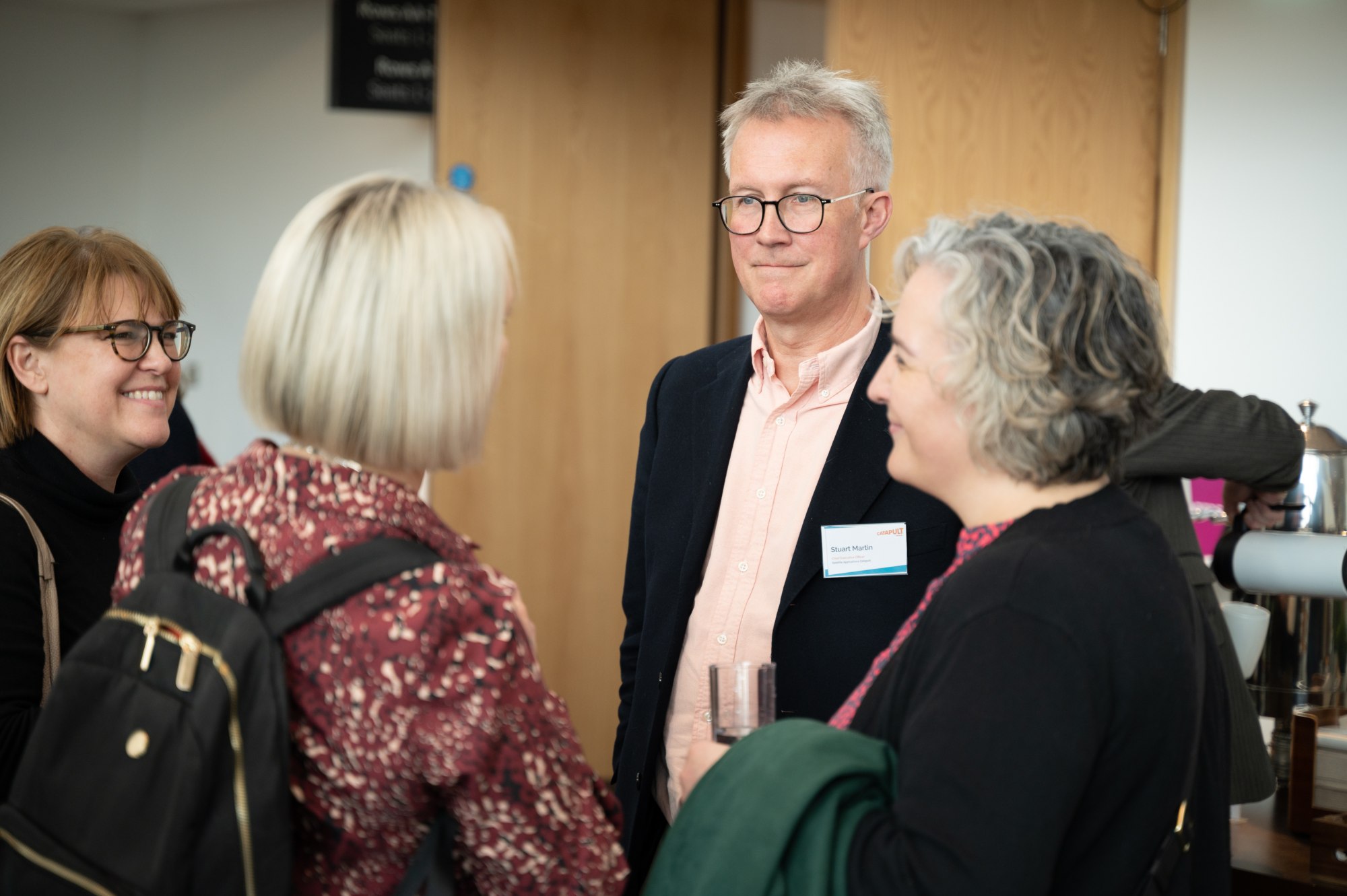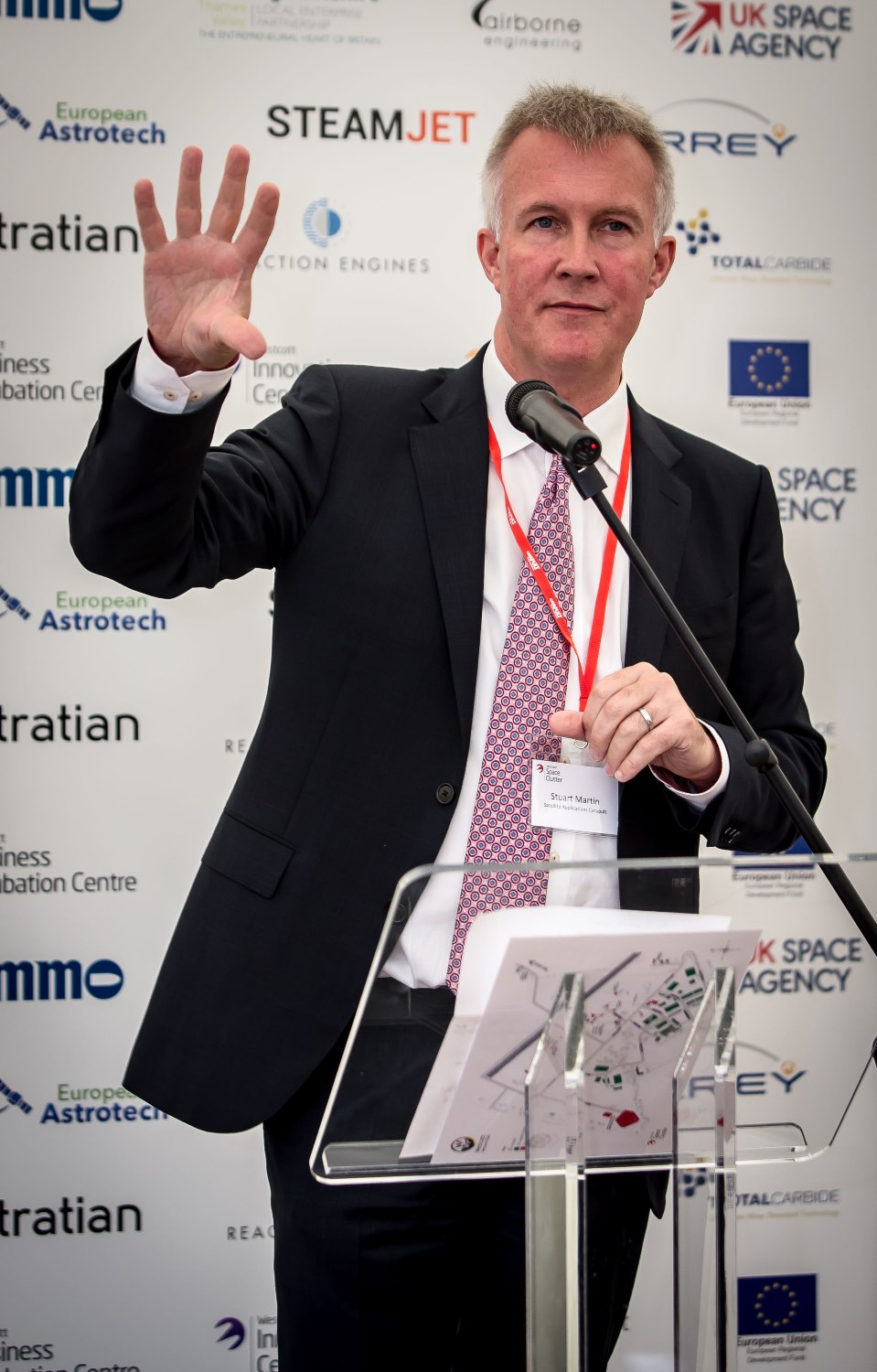Exploring a Catapult legacy with Stuart Martin
Stuart Martin signing the Catapult Network Charter
We sat down with Stuart Martin, CEO of Satellite Applications Catapult and founding member of the Catapult network, to talk about the mark he’s left on the UK space sector and the evolving mission of Catapults over his 10-years at the helm.
 Stuart Martin
Stuart Martin
Stuart, the Catapult concept was introduced in 2010/11, with Satellite Applications Catapult being one of the very first centres to be established. What was the gap that Catapults were created to fill?
Catapults are there to help industries form around emerging technologies. At the time we started, there was no real startup ecosystem in space. Our first challenge was to create one. The industry comprised a small number of large companies, and their supply chains. When we wrote our first business plan for the Catapult, we had to create fictional case studies for companies that did not yet exist in order to bring to life the opportunity, and show how the Satellite Applications Catapult would support the creation and growth of a new generation of space businesses.
One way we set out to achieve this was to locate ourselves somewhere we could encourage a space startup ecosystem to emerge – this was very much part of the early thinking of Catapults. There were existing centres in Stevenage, Portsmouth and Surrey which were all options for our location. However, the European Space Agency had recently chosen to locate its new UK facility alongside the government-funded Rutherford Appleton Space Laboratories at Harwell. Whilst there was next to zero industrial activity on site at this time, this was the location that was chosen. We rented our first offices in the Electron Building.
Another reason why the UK didn't yet have a startup ecosystem in space was because there was no private venture capital to support space startups. This was one of the very first things we set out to fix - to create an environment for space startups that was attractive also to venture capital.
Initially, the Electron Building had other tenants not related to space. As we grew, and as other space companies wanted to move in, we had to ask the non-space companies to leave. One of these tenants was a venture fund called Longwall Ventures. I met the principal one day in the queue for coffee. “I suppose you will soon be asking us to leave?”, he asked. “No”, I replied. “You can stay”. “Thank you”, he said. “But you should know I will never invest in a space company”. About a year later, Longwall became the founding investor in Oxford Space Systems, one of the very first new companies that was created at Harwell, and that has gone on to be very successful.
We sparked interest from other venture funds too. But working one fund at a time was hard work. We were targeting technology venture funds with a diverse portfolio, with the aim to secure one or (if we were very lucky) two investments into space companies. It was rewarding but took a lot of effort.
We quickly realised that we needed to create a dedicated venture fund for space. We worked with the British Business Bank (BBB), the UK Space Agency, and the UKspace trade association to build support for the idea and develop the concept. Eventually, the Seraphim Space Fund was created and this was a real game changer. It immediately meant that other venture funds started taking more interest in space, and has gone on to be one of the most successful venture funds that the BBB has ever supported.

How did it feel to create a new business from scratch?
It was exciting, but very challenging. Expectations were high, yet at the same time the precise model for Catapult delivery was still being shaped. We looked at many different options when thinking about how we should function. We could see that, whilst the existing space sector was very oriented towards government funded initiatives (one way, or another), there was a huge commercial opportunity. The question was how could we best unlock that opportunity by encouraging investment into new products and services, and generating demand from end users?
It was tremendously valuable and fulfilling to be working alongside other Catapult CEOs at this time, all of whom were tackling similar challenges. We met regularly to exchange experiences and learn from each other. It is a real strength of the Catapult model that individual Catapults understand the challenges and opportunities in their sectors in real depth, which means they can tailor and target their interventions very precisely. You don’t have the limitations of a ‘one-size-fits-all’ approach. So Catapults all ended up doing slightly different things in support of their industries. That’s the beauty of Catapults.
You've touched upon government interaction, business collaboration and underpinning finance. What about academia?
From the very early days we've aimed to generate strong and productive relationships with academic institutions. We mapped out what was going on around the country that was relevant to what we were doing. We set up a network of knowledge exchange fellows, and created relationships with many different universities including a particularly strong relationship with the University of Oxford, just up the road.
We felt we knew pretty well where space science was undertaken, but had a less clear idea of where science in the application domains was happening - such as in building and construction technology, agriculture, and mining. We mapped out the sectors with greater potential to use space technology, and fed this into our Knowledge Exchange teams to help join up and create linkages between academia and industry. We investigated opportunities for R&D projects to advance the state of technology and this work continues to be an important part of what we do as a Catapult.
For example, we have now delivered many projects exploiting the ability of satellites to observe and monitor large fixed infrastructure (mines, bridges, dams etc.) at fine detail. This all stems from work we did early on with Cambridge University. We start off with small collaborations, and have seen those deliver big impact. In a way, the things you can explore are endless, because satellite data can be applied so broadly and to so many different areas.
Another interesting thing about space is that the industry itself challenges conventional ideas of innovation flows. Generally, we consider that new knowledge flows from science into industry, where it is then translated into new products and services for customers. In the space sector, the major role for science is itself as a customer. The expertise of industry is used by science in the pursuit of new fundamental knowledge, which is not in itself of value to the industry. This is quite different, for example, to how the life sciences sector works.
 Catapults were set up with a specific remit but in a lot of cases they've had to evolve and expand beyond their original remit. Is that a fair assessment?
Catapults were set up with a specific remit but in a lot of cases they've had to evolve and expand beyond their original remit. Is that a fair assessment?
Absolutely. The frontier of innovation is moving all the time, so to stay relevant Catapults have to move with it. This applies to the Catapult model itself. For example, after setting up our base at Harwell it was clear from speaking with industry and other stakeholders they wanted us to do more around the country to enable other locations to take advantage of the opportunities available in space. In response, we created a number of regional Centres of Excellence, each with a two-way, mutually beneficial flow of knowledge and expertise with the ‘hub’ at Harwell. This was not considered part of the original goals for Catapults, which were very much to focus on a single location. This was long before ‘levelling up’ or ‘place-based innovation’ became government policy.
We started off by setting up three centres; in Glasgow, in Leicester and in Durham, each seeking to develop opportunities based on their own unique environment. Over time, and these days in partnership with the UK Space Agency, we’ve supported centres in other locations too. Each has developed its own identity, and support each other via the network – some still getting support, and others operating more independently.
When Hermann Hauser, the author of one of the key reports that recommended creating Catapults back in 2010, undertook a review of Catapults in 2015, he was particularly interested in hearing about where Catapults were doing things that were not initially envisaged. This regional approach was one of those areas. He was pleased to see we were delivering against our mission in Harwell but also leveraging capability to boost activity elsewhere.
Ultimately, it's about maximising the return on investment in the Catapults to benefit the whole UK economy. As a nation we have tremendous resource, skills, and capacity across the country, which we are still not making full use of. Catapults are a very useful tool for unlocking some of these opportunities.
You’ve spoken about how Catapults can help businesses to firm up the economy. In the wake of so much uncertainty, what do you see as the role of Catapults in driving sustainability?
There are so many different sustainability challenges. Environmental sustainability, climate sustainability, sustainability of jobs, of living standards, of energy supply, of natural resources, the space environment, the list goes on. Every industry has its own sustainability challenges. Catapults are unique in their ability to see right across the innovation landscape at the system level – where all of these challenges intersect as a set of high level “unmet societal needs”. There is huge potential to make use of our system level insights to plan and stimulate development and deployment of economically sustainable solutions to these unmet societal needs, which will require a combination of technological advancement and industrial transformation.
Catapults have a lot to offer. If we want to be one of the first countries in the world to wean ourselves off oil and gas, then we need to be ahead of the curve and lead in the adoption of the technologies that will enable it. This is really hard to do; it's risky and those investing in transformation need to have confidence in those who are leading us through the journey. By demystifying technology solutions in a way that generates confidence and helps buyers make those difficult adoption decisions we can dramatically accelerate advancement. I think that's a critical role for Catapults to play.
How about international?
Space has always been an international endeavour. Space is a global commons, so it is natural for countries to work together so that we can all get the best from it. It is important practically to coordinate access, and economically to share costs.
International engagement was always an important part of what we set out to do, and we applied a very similar approach to that of our regional centres. We approached the Science and Innovation Network (SIN) and got a lot of interest from South America, initially in Chile and later in Colombia and Brazil. Post Brexit, international collaboration is even more important now than it ever has been.
 What benefits have you seen from collaboration with other Catapults across the network?
What benefits have you seen from collaboration with other Catapults across the network?
Initially, it was difficult to identify collaboration opportunities. We were all in start-up mode, and were learning a lot from one another about developing best practice to get our organisations up and running quickly and effectively. Interaction was mainly about an internal support network and that worked really well.
In the last few years, all the Catapults have found their feet in their own industries and established their own identities and we've started to leverage opportunities across the network. For example, seven Catapults are collaborating on the Hydrogen Innovation Initiative, and five of us are working together on Energy Efficient Networks. These are both very high potential pieces of work.
Most recently, a Satellite Applications Catapult spin-out, Space Solar, has welcomed input from five Catapults. This has the potential to open up access to a new source of clean, cost-effective baseload energy, which could form a significant part of future national and global energy plans.
Just a few examples of where Catapults are already demonstrating strong strategic alignment, and this is only going to get stronger.
How can the network help address some large-scale challenges that the UK and other countries are facing?
Most of the science and innovation support in the UK is focused at the science and technology development end. Solutions to the most critical global challenges will require interventions and innovation delivered through new infrastructure, products and services and within markets themselves, as well as in science and technology. That is where Catapults have a unique role to play, because we sit between ‘the science’, the ‘technology development’ and the ‘end-users’. End users in all industrial settings have needs that are not currently being met, but they don’t know where solutions will come from so they can’t specify requirements for them. They are calling for transformational change - disruption. Catapults can help facilitate that change. Waiting for changes to emerge incrementally from the bottom up is not going to get us where we need to be.
The UK needs to make transformational bets and create new types of infrastructure. For example, the energy sector will require entirely new energy infrastructure, domestic power systems and domestic heating systems. Taking advantage of Catapults as incubators to get these transformations started could be a key enabling step towards accelerated progress. Exploiting our existing translational infrastructure will help us to solve national and international challenges with more consistency and drive towards better outcomes.
In terms of future development, what roles can Catapults play in industrialisation?
The key word here is ‘Industrialisation’. How can we accelerate the formation of new industries around emerging technologies? Note that this is different to ‘Commercialisation’, where a new technology is “pulled through” by an existing industry – for example satellite navigation in cars. Industrialisation is a more transformative process and generally takes place in environments where Commercialisation is, for whatever reason, inhibited. It very often requires a disruptive event, which causes industrial change. For example, the entry of Tesla into the automotive sector which caused all other vehicle manufacturers to embrace electric vehicle technology.
The structural impediments to industrialisation can be very significant, e.g. high capital costs, regulatory barriers, the existence of strong incumbencies, and industrial inertia. At the same time, the demand signals from potential customers can be very weak even if you are responding to well-established unmet needs. This is because you are not delivering into a developed market where the buyer is knowledgeable and confident. A change in buying behaviour will be needed. Both deployment and adoption are high-risk, and potentially high-cost endeavours, yet both are necessary for advancement.
This is where Catapults can play a pivotal role. Catapults can provide systematised support structures that help address the challenges of deployment and adoption at the same time, creating greater opportunity for new markets to form, faster. Whether that be providing manufacturing facilities, testing facilities, or facilitating collaborations between providers, adopters and regulators, we already have some great examples of where the UK has done this well. For example, in offshore wind energy, we’ve developed the ‘contracts for difference’ system which has accelerated demand for industrial output, which the Offshore Renewable Energy Catapult is now helping industry respond to. There are many other examples already, like in cell and gene therapy, but there is still much more opportunity than we are currently taking advantage of.

What's your advice to the UK Government?
If we want to be a 21st century innovation nation, we must learn again to be the world-class adopters of technology, as well as its providers. Just like we were in the 19th century, when we led a global industrial revolution based on steam – not by exporting the technology, but by using it. We talk about the UK ‘productivity gap’, which has at its heart the fact that we are not as good at adopting and using new technologies as our competitor nations are. We need a cultural shift which is more embracing of positive technological change, and that needs to start with government. In public services and public procurement - we need to become a nation of innovation adopters again. We need to relearn the value and skill of being first.
What has been your proudest achievement as CEO? And what will you miss the most?
There are so many things I'm proud of. The stimulation of the space ecosystem and the encouragement of venture capital ranks highly. The establishment of Harwell as the centre of the UK's space industry. The Catapult can't take full credit for any of these things, but, along with other stakeholders, we've clearly played an important role in bringing these changes about. I am really proud of the centres that we've created around the country and what they have become. And the many projects that we have delivered, and companies that we have supported.
But I think the thing I am most proud of is the people that we've brought through. Over the past 10 years I have seen so many people join the Catapult, many of whom without any previous experience of the space sector. I’ve watched them grow and develop their careers, move on to other businesses around the country and around the world and many start their own companies. There are so many people doing such amazing things! People are the backbone of any business, and that is especially true at the Catapult. I feel blessed to have been able to share my time at the Catapult with such a wonderful, talented and motivated group of people.
 And now for our final question. What’s next for you after your departure as CEO of the Satellite Applications Catapult?
And now for our final question. What’s next for you after your departure as CEO of the Satellite Applications Catapult?
I'm not sure I will have more free time after leaving the Catapult, but I do enjoy spending time with my dogs and horses and playing golf. From a professional standpoint, I shall continue supporting Space Solar - a company that has recently spun out from the Catapult on a mission to create a new source of sustainable base load power from space. This technology has the potential to scale and transform the energy sector across the whole world, and is just one example of the ways that space technology is going to change all our lives for the better in the 21st century. So, other than that, watch this space.
We thank Stuart for his continued support to Catapults and the invaluable contributions made by him throughout his legacy.
